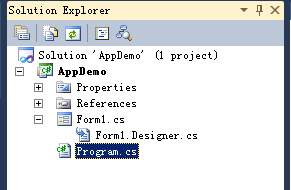在 windows 下使用 vs2010 开发,未深入研究。
c# 与 .net 开发,一堆又一堆的新名词,头晕目眩,比如 CLR / apartments / STA / MTA / COM
吐槽无力,只一个问题:微软真的是软件公司,而不是文学公司?
创建 Windows Forms Application 工程后,自动生成如下代码:
用一个 App run 一个 form。
[STAThread]/[MTAThead] 指定单/多线程运行模式。
using System; using System.Collections.Generic; using System.Linq; using System.Windows.Forms; namespace AppDemo { static class Program { /// <summary> /// The main entry point for the application. /// </summary> [STAThread] static void Main() { Application.EnableVisualStyles(); Application.SetCompatibleTextRenderingDefault(false); Application.Run(new Form1()); } } }
其中,Designer 中定义样式。时间监听、时间处理都在 form.cs 中定义。
双击 form.cs 会打开 UI 效果界面,可以直接拖拽定义界面。右键 view code 可以查看 form.cs 源码。

form1.cs 与 designer 定义的是同一个 namespace 下的 同一个 class
每一个文件定义时,都使用了 partial class
界面布局的代码,一般自动生成,在 Designer 中。
手写的代码注意是事件处理,一般放在 form.cs 中
form.cs 的构造函数中,都会调用 Designer.cs 中定义的 InitializeComponent() 完成界面初始化。
Designer.cs 中,InitializeComponent 初始化界面,声明每个空间的索引 logs_code"> private System.Windows.Forms.Button button1;
在 form.cs 中可以直接用过变量名 button1 操作该控件。
另外,Dispose 方法释放资源。释放时需要注意不要造成资源泄露。
// --------------- Form1.cs ----------------------------------- using System; using System.Collections.Generic; using System.ComponentModel; using System.Data; using System.Drawing; using System.Linq; using System.Text; using System.Windows.Forms; namespace AppDemo { public partial class Form1 : Form { public Form1() { InitializeComponent(); } } } // ------------------- Form1.Designer.cs ------------------------- namespace AppDemo { partial class Form1 { /// <summary> /// Required designer variable. /// </summary> private System.ComponentModel.IContainer components = null; /// <summary> /// Clean up any resources being used. /// </summary> /// <param name="disposing">true if managed resources should be disposed; otherwise, false.</param> protected override void Dispose(bool disposing) { if (disposing && (components != null)) { components.Dispose(); } base.Dispose(disposing); } #region Windows Form Designer generated code } }
exe 或者 dll 文件需要依赖其它文件得以正常运行,
最简单的做法是:把依赖文件拷贝到客户端,程序内部用相对路径读取。
这一般是可以的,但若客户删除了这些资源,则会导致不可预见的效果。
通过资源文件,可以把这些文件嵌入到 exe 或者 dll 中。
资源文件可分为 2 类:.resx 和 .resources。前者是xml格式,后者是二进制。
只有当前solution存储同名的 .cs 文件时,.resx 文件才能正常工作。resources 则无此限制。
通过 System.Resources 下的 ResourceWriter 可以生成资源文件
创建实例后,即可通过 AddResource 方法添加资源。第一个参数是标示符,可以在代码中通过标示符使用资源。
资源文件中一般存三种类型的数据:byte流(byte[])、对象(object)和字符串(string)。
Generate 产生文件,Close 关闭文件
ResourceWriter rw = new ResourceWriter ( "filename.resources" ) ; rw.Generate ( ) ; // 产生文件 rw.Close ( ) ; // 添加资源 public void AddResource ( str_identifier , byte [ ] ) ; public void AddResource ( str_identifier , object ); public void AddResource ( str_identifier , str_value ) ;
resources.ApplyResources( this.myButton, str_identifier ); // 为 this.myButton 使用资源 str_identifier
this.ApplyResource();
在界面上添加组件后,会生成 .resx 文件,vs2010 中折叠在对应的 form.cs 下。
这是默认语言的资源文件,文件名为 form1.resx
若要开发其他语言版本,在对应 form 右侧的属性菜单中,将 Localizable 设为 True,并将 language 设为所需语言即可。
设置新的显示文本后保存,会生成对应语言的 .resx 文件。文件名格式为 form1.language-Location.resx。简体中文为 form1.zh-CN.resx
1. 仅当 Language 为 default 时才可以添加或删除界面中的组件。
2. 仅当设定为新language,且修改过显示文本,才会创建对应的资源文件。
3. 仅当选定 form 时,才能在右侧属性菜单中设置语言。若选中 button、text 等组件时,无法设置属性。
4. 添加多国语言支持后,默认语言的 form1.resx 中不再包含显示文字 Text、控件大小 Size、显示位置 Location 等,通过 ApplyResources 来设置。

两个关键概念:
System.Globalization.CultureInfo.InstalledUICulture.Name; // 获取当前运行语言 System.Threading.Thread.CurrentThread.CurrentUICulture = new System.Globalization.CultureInfo( "zh-CHS" ); // 设置当前运行语言
monospace;">SuspendLayout() 调用后控件的布局逻辑被挂起,直到调用 ResumeLayout() 方法为止。
当调整控件的多个属性时,将先调用 SuspendLayout 方法,然后设置控件的 Size、Location、Anchor 或 Dock 属性,
最后调用 ResumeLayout 方法以使更改生效。